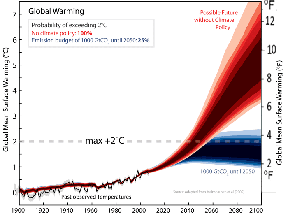It's odd, being edited - seeing phrasings you'd never use (most of which are improvements) appear under your name. It'd be more transparent if the editor was listed as a coauthor; now that we have the web and infinite space, why not do that, on a mouseover?
One dimension that was lost, in the post up on Gristmill, was the mouseovers; I'd composed the writing so mousing over virtually every link provided some context. Rather than consign that work to wasted effort, I've reprinted the story, as I submitted it (sans editing, plus title tags) here:
The AP's Climate Conference Footprint Fetish
"The AP writer couldn't see the forest for the trees." - Terry Tamminen
"The fact is, we live in a glass house today, folks, and sometimes we become part of the story whether we want to be or not." - Lex AlexanderWhat a difference vision makes.
Last week, CJR Observatory's Cristine Russell wrote about the Climate Change Media Partnership venture, which is enabling journalists like Brazil's Gustavo Figueiredo Faleiros to cover the Poland climate talks for their home countries.
And Michael Staples of New Brunswick's Daily Gleaner reported local high school student Taryn McKenzie-Mohr was Poland-bound, to meet and discuss climate change with other youth delegates.
And the Associated Press? Well, to judge from their stories before other climate conferences, for the AP the news isn't people like McKenzie-Mohr and Faleiros going to the climate conference, it's emissions from the flights to get them there.
"That kind of thinking is small"..."pernicious"... "Kind of like saying the toilet didn't work well on the lunar lander in 1969 - - but, oh yes, they landed on the moon!"
And what will looking into such episodes reveal, about AP culture?
Join me as I find out.
In the past year, three AP stories, related to two climate conferences - Bali in December 2007, and Schwarzenegger's Global Climate Summit in Los Angeles last month - have stuck out like a trio of small-thinking sore thumbs. They are Samantha Young's "Schwarzenegger summit: A sizable carbon footprint" from last month, and two stories from last December, Jakarta Bureau Chief Robin McDowell's "Climate Change Meeting Adds to Emissions" and Stockholm Bureau Chief Karl Ritter's "Climate skeptics say debate stifled" (Although the latter isn't a "conference footprint" story, it too has a "miss-the-forest" mindset.)
Young's "footprint" story from last month entailed considerable effort, including a public records request and help from three other Sacramento political reporters. But the resulting story's focus dismayed essentially everyone in it. According to Terry Tamminen, who co-wrote a rebuttal ( The measure of environmental leadership ) with CalEPA secretary Linda Adams, "The Governor's office worked with the AP writer to give her background about the entire Summit and everyone was stunned that her focus turned out to be the carbon footprint". And the three nongovernmental sources in the story - who report they weren't contacted until the day before it appeared - say the reporter was vague about its direction: "she just asked me to comment on the conference", said one; "I don't know what prompted it to take the form that it did", reported another. The strongest criticism came from Carnegie Institution climate scientist Ken Caldeira, whose views on carbon offsets had been used to bolster the story's anti-conference message. "I think this whole line of argument about how much greenhouse gas emissions come from conferences about greenhouse gas emissions reduction is pernicious", he said. "This is reminiscent of the attacks on Gore. The success of the summit is far more important than any CO2 that might be emitted traveling to or from the summit."
You might wonder, why would this story's author force it in a direction that everyone involved considers a pointless distraction from an urgent issue; particularly when, as one California climate journalist informs me, "actually, she's a very good reporter"? And how - and by whom - was the story deemed to merit the efforts of four political reporters?
I tried to find out from the AP, to no avail. The Sacramento reporter who answered my call immediately passed me to the group's overseer, who said neither he nor the others could discuss the story without prior permission from AP San Francisco Bureau Chief John Raess. Mr. Raess himself isn't talking - "As a general rule I don't comment publicly on the internal editorial process behind an individual story... [N]othing about this story...would seem to merit an exception"; and didn't grant me permission to speak with the reporters. The witnesses aren't talking, but we can still infer the Sacramento story's heritage. It appears to be modeled on AP Jakarta Bureau Chief Robin McDowell's Bali conference "footprint" story "Climate Change Meeting Adds to Emissions" (Dec. 5 2007). This story is itself a rewrite of a London Sunday Times story, "UN climate circus rolls in on CO2 cloud" (Nov. 25 2007), whose own predecessor appears to be a Sunday Times story scolding Prince Charles for his carbon footprint ("Green prince leaves a giant CO2"; June 24, 2007). These three stories all feature carbon analyses by Chris Goodall, author of "How to Live a Low-Carbon Life: The Individuals Guide to Stopping Climate Change".
A close look at the Sunday Times "Bali conference footprint" story, and then at the AP rewrite, yields interesting - perhaps meaningful, perhaps not - patterns of variation. The Sunday Times story appears inconsistent in its message: emissions from the conference, termed "a major contributor to global warming" at the outset, by the end faded to (if you do the math yourself; the article just gives the raw number) roughly 1/66,000th of the annual estimated emissions of Britain.
The subsequent AP rewrite has a more consistent "anti-conference" message, which it achieves by diminishing content that would call this message into question: the comparison with Britain's annual emissions for context is gone, and the story's final, key quote is much weaker. Where the Sunday Times story had closed with a strong justification for the conference:("The emissions from Bali, although huge for such an event, remain small on a global scale. Britain, for example, emits the equivalent of 660m tonnes of CO2 a year.")
"Achim Steiner, director of the UN Environment Programme, said such conferences could never be small. "If you want to tackle an unprecedented global challenge like climate change then people have to meet and talk. Bali remains the world's best hope to minimise the effect of global warming." "
...the McDowell AP article closes with a weak one:
"It may sound like a lot of people, [b]ut you have to look at the issues, the number of countries involved, the number of people affected. Global warming is literally everyone's business."
"But critics say [the conference-goers] are contributing to the very problem they aim to solve".
These critics turn out to be one Chris Goodall, the gentleman commissioned to perform the original story's carbon analysis.
You might wonder why Ms. McDowell chose to adopt the Sunday Times's "small thinking" meme, and reshape the story to increase its outrage factor.The third AP "small thinking" climate story is Stockholm Bureau Chief Karl Ritter's "Climate skeptics say debate stifled". Appearing the week after McDowell's "Bali footprint" piece, it gave voice to the dismay of Danish political scientist/statistician Bjorn Lomborg and other climate contrarians, at being shut out and disparaged by the climate science and climate action communities. The story made no serious attempt to determine whether past and present circumstances justify such treatment.
You might wonder why Mr. Ritter didn't address this more important issue.
(According to this Daily Kos comment, the Bureau Chiefs decide which stories go out "on the wire"; so it seems more likely that a story written by a Bureau Chief would go out exactly as written, without editing or filtering - which could be a boon to public relations firms.)
I'd like to give you a clearer picture; I'd like to be able to put these questions to those who could answer them, and share with you their answers. But the AP's Director of Media Relations hasn't been willing to answer questions himself or to pass me on to others who would.
Journalist Lex Alexander of the pioneering Greensboro News and Record weighed in on this mindset back in 2005:
"The fact is, we live in a glass house today, folks, and sometimes we become part of the story whether we want to be or not.And we've got three ways we can respond. We can get all defensive and arrogant. We can take the kind of absolutely silent approach that comes across as defensive and arrogant. Or we can acknowledge in fact what we always say whenever we're pushing for more liberal open-records laws: We're a public trust. We work for the people. And if we're smart, we're going to work _with_ the people as well, and talk to the people about how we can best do that."
He's right.





